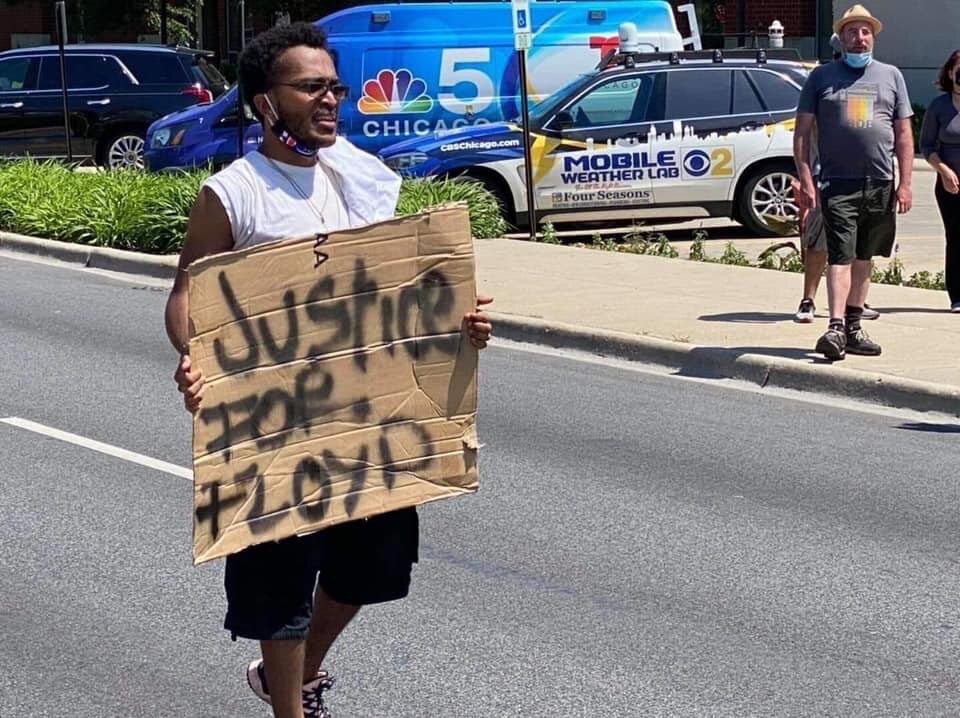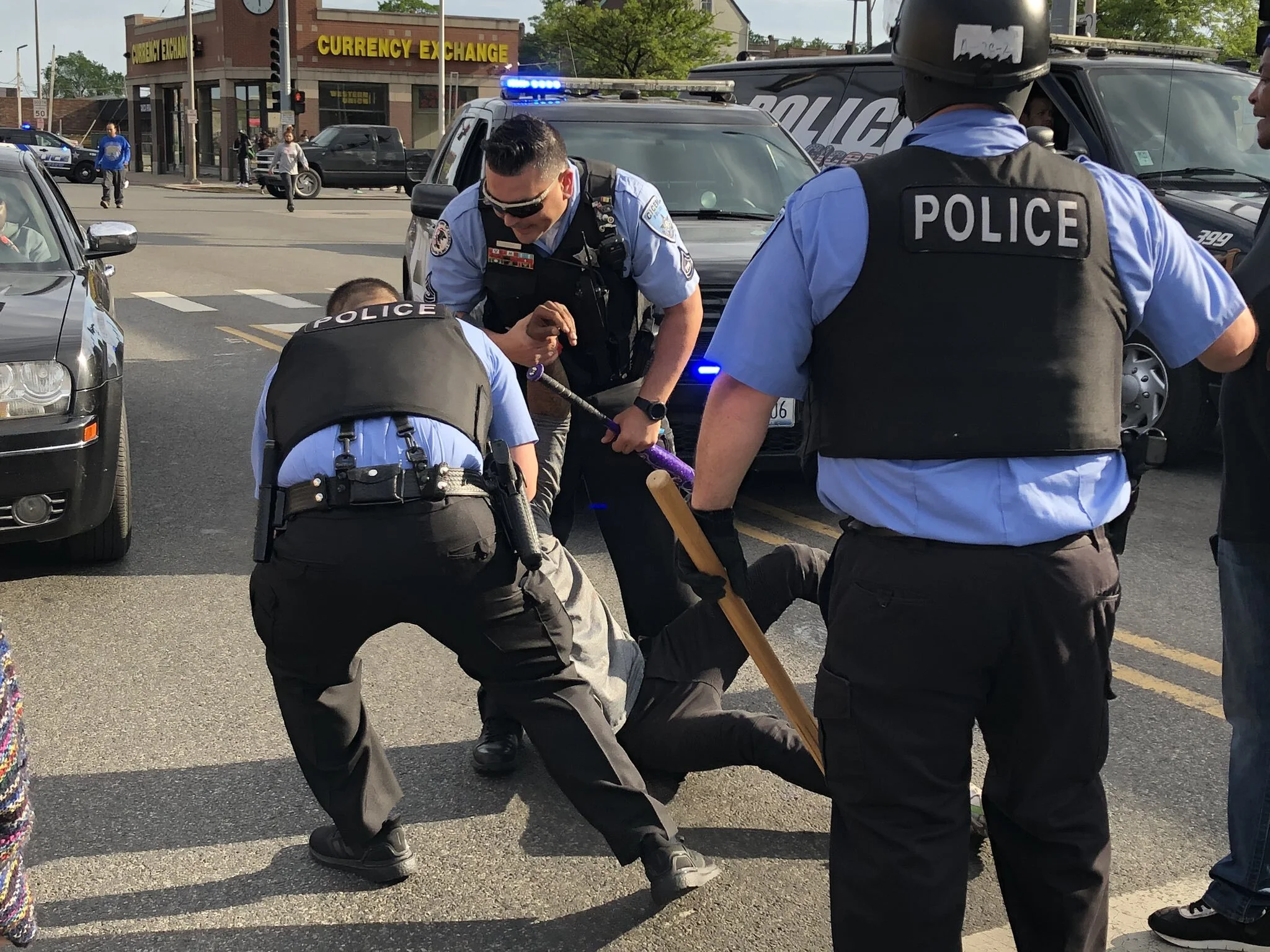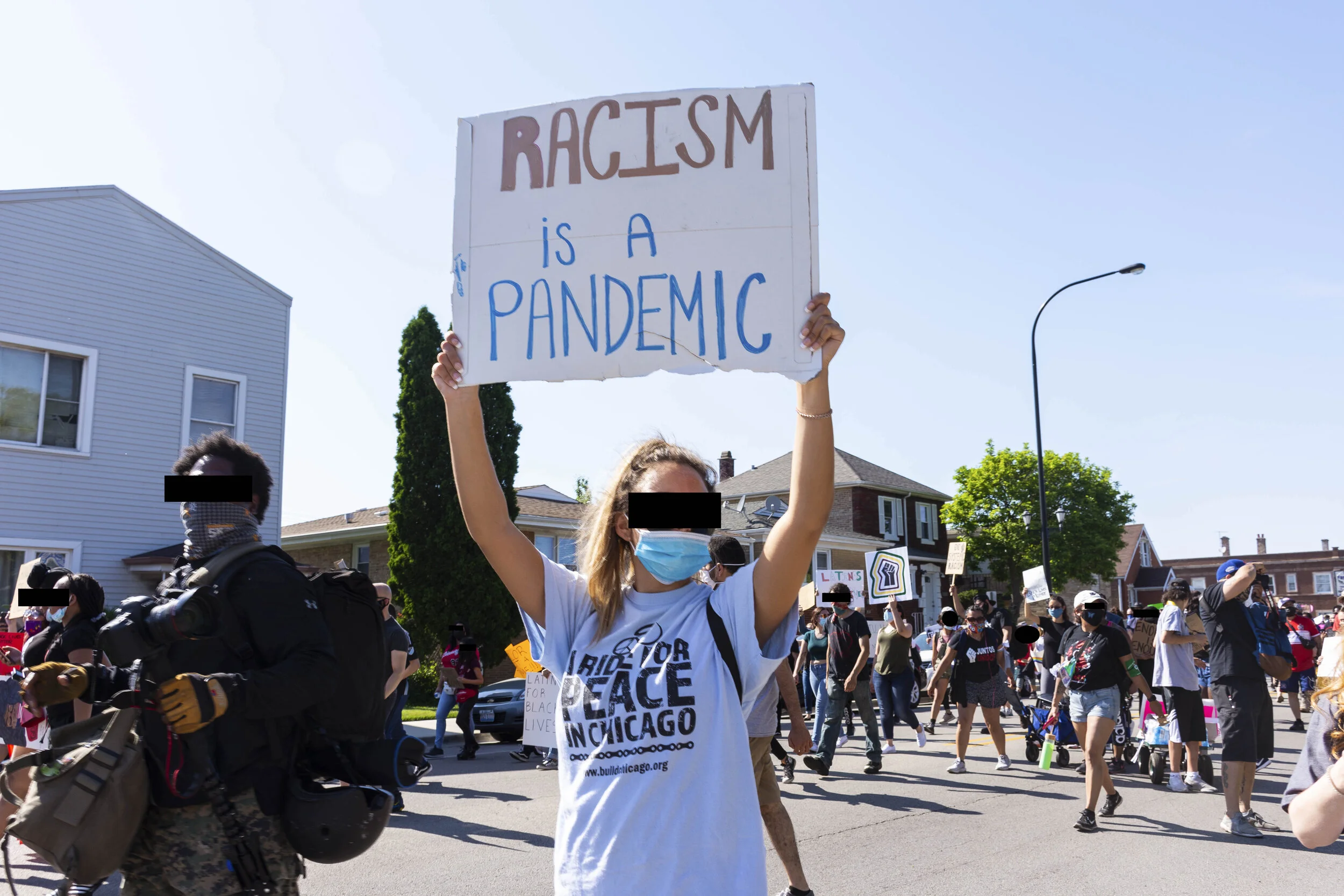Black Cicero Residents React to June 1 Unrest
Illustration by Adelaida Montero, college senior at Denison University studying in Education and Studio Art
By Shapearl Wells and Irene Romulo
Cicero was once considered a sundown town—a place where Black people could work and shop but could not be in after nightfall because of possible violence towards them.
Although the white mobs, who once burned down the apartment of Harvey Clark Jr., a Black bus driver who dared to move into Cicero in 1951; and that murdered Jerome Huey, a young Black man who came to Cicero for a job interview but was instead beaten to death, may be gone, some Cicero residents say anti-Black hostilities can still be felt in the town.
These hostilities escalated on June 1. After a weekend of mass protests against the murder of George Floyd by Minneapolis police, Chicago mayor Lori Lightfoot shut down access to downtown, the epicenter of the activities, forcing protests and the property destruction that unfolded to spread to communities on the south and west sides of the city, including Cicero.
The Town of Cicero responded by calling in the state police, implementing a curfew, enacting road closures and declaring a state of emergency.
Armed with wooden bats and rocks, non-Black Latinx individuals also decided to stand on corners that day, claiming to protect local businesses, as many declared on social media. Protection of property, Black and non-Black residents say, instead turned into the targeting of Black people in the town.
While Cicero police have denied encouraging residents to act as vigilantes and posts on their official Twitter account encouraged residents to stay at home, both Black and non-Black residents say that police did not do enough to protect Black residents and disperse the crowds that gathered. Videos surfaced all over social media showing police standing by as groups of armed men intimidate and attack people on the street.
Screenshot of the Cicero Police Department’s response on Facebook to Elliot’s video.
“I called the Cicero Police Department because I was seeing a lot of videos on Facebook of gang members standing on the corner of Cermak and Austin,” said Rashad Elliot, a Garfield Park resident.
On June 2, Elliot posted a video on Facebook that captures a call he made to the Cicero Police Department (CPD) where he asks the police sergeant on the phone how CPD is planning on keeping Black people safe from the attacks.
In the video, the sergeant can be heard responding to Elliot’s concerns with a dismissive tone. The sergeant responds, “Do you understand people are coming over here and just shooting at random Mexicans? They are protecting their neighborhoods.”
At a press conference Jerry Chlada Jr., the Cicero Police Superintendent, said allegations that CPD was working with gangs were “ludicrous.”
“A lot of our problems that occurred were from groups of citizens who were encountering groups of protestors. The citizens were trying to protect their neighborhood,” he said. “There were a lot of clashes which resulted in a lot of fights.”
There are a little over 3,000 Black people living in the town of over 84,000 people according to the latest Census figures. Black people in Cicero are “a minority amongst minorities” as Geremy Webster, a Cicero resident for twenty years, put it.
“I don't know if people would still be willing to come to our aid as a Black family if we needed that aid. so no I don’t feel as I did before these riots occurred.” - C.S.
C.S., who declined to use her full name for fear of retaliation from her employer, has lived in Cicero for almost eight years. She learned of the disturbances happening on June 1 on the news. At first she felt outrage and hurt which led to disbelief that the actions she was hearing about were, as she believed, being allowed and encouraged by local police.
“[Cicero police] could have patrolled the streets better so that the gang members could have understood that their ‘services’ were not needed,” said C.S. over the phone. “They were out in the open like it was okay...and they weren’t discouraged from doing that.”
“[Living in Cicero] hasn’t been bad. My neighbors seem to be friendly and our precinct captain lives on this block so he has checked on us,” C.S. says. However, C.S. now feels like she could be a target on her block where there are only three Black families.
C.S. says the Town government could help bridge Black and Brown communities by increasing opportunities for residents to come together. She likes to be involved, but has had a hard time attending local community events in Cicero because Town Board meetings and activities are held during the work day. She thinks there should be more inclusive activities in the afternoons as well as more outreach and promotion to ensure that people find out these events are happening.
“Cicero has always been a Town that people have known to be racist.” - Mary Preston
Mary Preston has lived in Cicero for nine years and says that it is difficult for her and her children to feel accepted here. Events on June 1 exacerbated those feelings of alienation.
“It’s like we shouldn’t have to be afraid within our own community...because you feel like someone from another race is going to attack you. Especially when they are the majority of people around you,” Preston explained over the phone.
Preston has encountered issues with the school district who she says has not done enough to accommodate the few Black students currently enrolled. She has had to advocate for her child, who requires special education accommodations, on numerous occasions to ensure that he gets proper attention and does not feel left out.
“Some of these parents may be scared to report things because they may be immigrants or they don’t speak English but I’m going to advocate for mine regardless,” she said. Part of the problem, as she explained, is the lack of Black teachers in the district.
An analysis from 2018 shows that only 1.2 percent of teachers in District 99 are Black. Other issues Preston identified are curriculum and activities that focus solely on non-Black students and a lack of government sponsored events for the Black community.
“Growing up here in Cicero we didn't really have a lot of Black history being talked about. People don’t understand where we come from. If they did they probably might say, Hey man they just like us.” - Geremy Webster
Photo Courtesy of Geremy Webster
Webster moved to Cicero when he was eight years old. On June 1, he says his Afro-Latinx friend was harassed by a group of weapon-wielding residents when she was stopped at a red light.
“I feel fearful as a Black man every single day of my life but definitely with what was going on in Cicero— yes, because they tried to put the Brown and Black communities against each other and you know it was just a high alert on people that was out here harassing the African-American communities,” he explained.
As an artist Webster feels it is his duty to spread peace through music and help residents understand that going to war with each other is not the answer. He attended several of the Black and Brown solidarity marches held in the days after June 1 where he shared thoughts about his culture so that non-Black residents could understand why some Black people regularly feel under attack.
According to Webster, there should be more opportunities and events in the town for residents of different races to come together to learn about the history of Black people in the United States.
“Black history is history,” he said. “I should know more about my history…we should do more for the appreciation of Black life.”
“I’m not sure if we’re that big of a priority to the Town government.” - Brent Wells
Photo courtesy of Brent Wells
Brent Wells has lived in Cicero for almost 17 years. He heard about the events of June 1 from his wife and daughters.
“My daughters were worried. They were scared to go outside,” Wells shared. “They live here, they grew up here and that’s a huge concern for me especially because the makeup of the city is predominantly Latino and then being us, as Black or African-American we’re like a small percentage of the city so that was a huge concern of mine.”
Wells believes the Town of Cicero could do more to help bridge Black and non-Black communities in Cicero. Increasing the number of Black people employed by the Town can be a place to start as well as having more intentional celebrations of Black history and culture.
“Everybody knows about July 4 which is Independence Day, but nobody knows about Juneteenth which was Independence Day for Black people. Let’s start there, say a celebration where it can be something for us, but also educate everyone at the same time.”
“Our town cannot go through ground zero...we don’t need any fighting between any race.” - Joshua Tate
Joshua Tate during a march on Town Hall in Cicero, IL on June 2nd, the day after black people in Cicero were harassed by non- black latinx people. (Photo courtesy of Luz Chavez)
Joshua Tate has lived in Cicero for about 15 years. He says living here is generally peaceful. Tate believes that headlines of race wars in Cicero as well as videos on social media of individuals threatening retaliation helped to fuel division amongst Black and non-Black Latinx residents.
Tate, like many community members, believes that Cicero police did not do enough to protect Black residents.
“Cops gotta stop people from killing each other. They are here to protect and serve, not instigate and incite riots,” he says.
Tate attended several of the solidarity protests held after June 1 and is thankful that people were willing to show unity.
“We showed that we could unite together and we could do this peacefully. They don’t have to worry about property being damaged. That’s what it mainly was about,” Tate explained.
Moving forward Tate says it is important that Cicero residents begin the work in their own homes by teaching young children not to hate those of other races. He also wants Cicero residents to know that people, “don't know about the power of minorities united. That’s why we need to unite and do this the right way.”
Shapearl Wells is a longtime Cicero resident. She is the host of Somebody, a podcast that follows her investigation into her son’s murder that is co-produced by Topic Studios, the Intercept, and the Invisible Institute. She also runs the Courtney Copeland Memorial Foundation.
Irene Romulo is co-founder and editor for Cicero Independiente.














